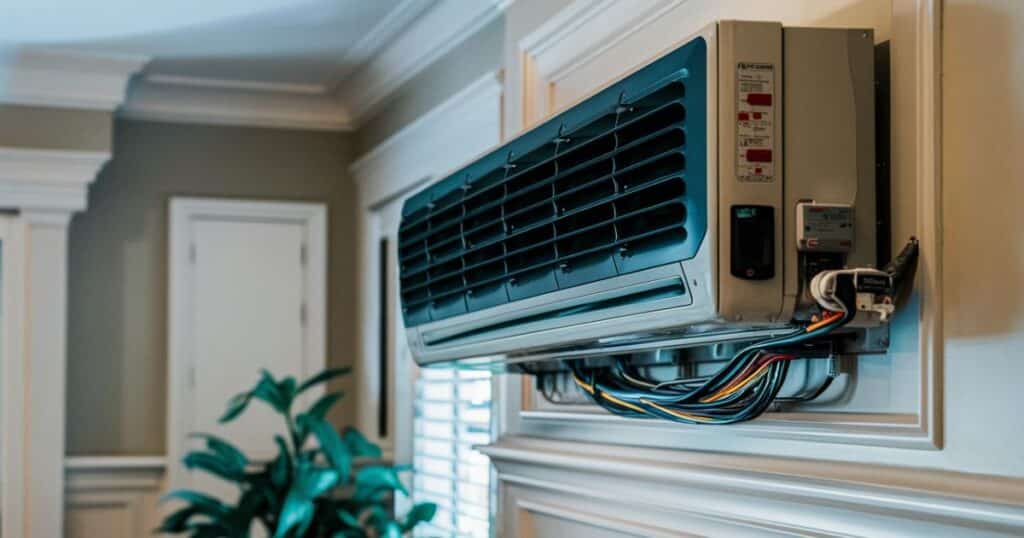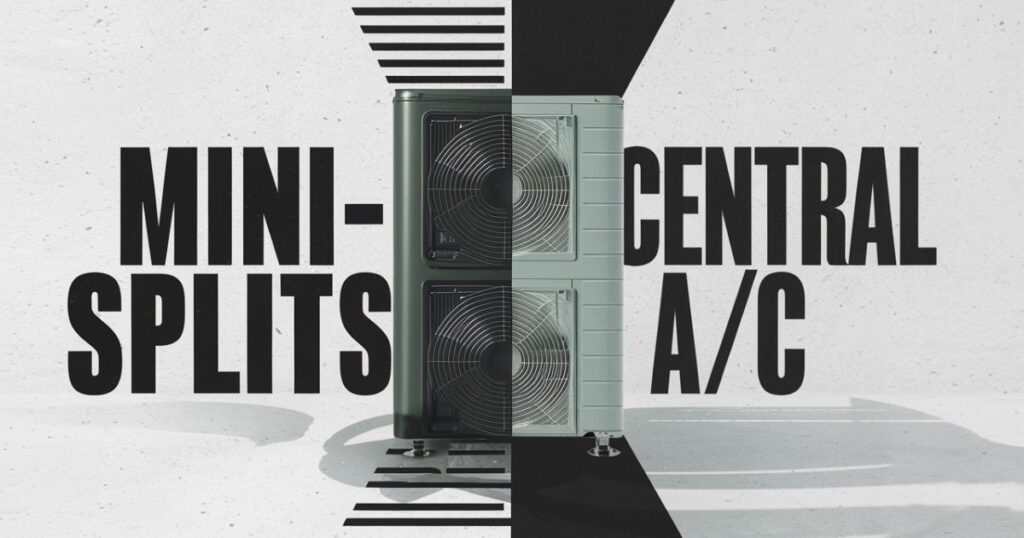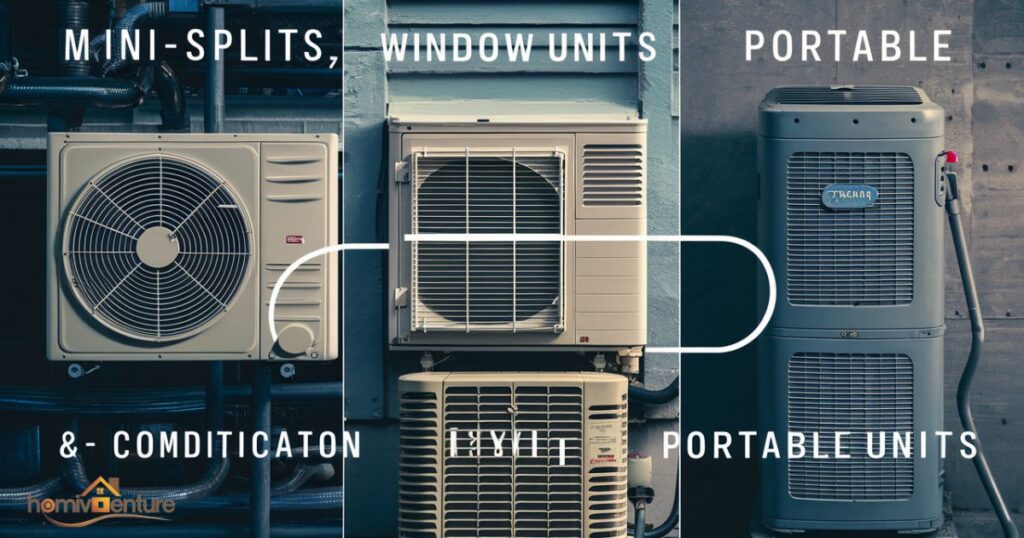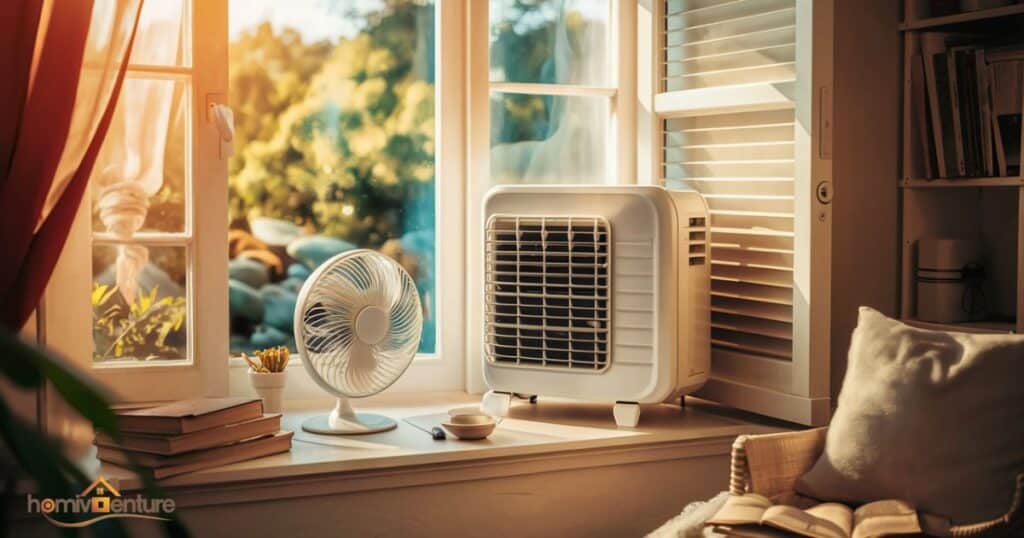Mini-split reviews offer comprehensive evaluations of these versatile HVAC systems, providing valuable insights into their performance, features, and overall suitability for different environments. These reviews cover crucial aspects such as energy efficiency, cooling and heating capabilities, noise levels, installation requirements, and user experiences.
Potential buyers can benefit from detailed comparisons between different brands and models, helping them make informed decisions based on their specific needs and preferences. With easy-to-understand summaries and expert analysis, mini-split reviews serve as valuable resources for anyone considering investing in these efficient and customizable heating and cooling solutions.
How Ductless Mini-Split AC Systems Work
Ductless mini-split AC systems work by using two main components: an outdoor compressor/condenser unit and one or more indoor air-handling units. These units are connected by a conduit, which houses the power cable, refrigerant tubing, suction tubing, and a condensate drain. The outdoor unit compresses and circulates refrigerant through the indoor unit’s coil, absorbing heat from indoors and expelling it outside.

Inside, the indoor unit releases the cooled air into the room while absorbing heat from the indoor air. The refrigerant flows back to the outdoor unit, where the process repeats. Because there are no ducts involved, mini-split systems are more energy-efficient than traditional central air conditioning systems. Additionally, they offer greater flexibility in terms of installation and zoning, allowing for customized cooling in different areas of the home.
Overall, ductless mini-split AC systems provide efficient and customizable cooling solutions for homes and businesses. Their simple yet effective operation makes them an increasingly popular choice for those seeking comfort and energy savings without the need for extensive ductwork.
Related Content: The Truth About Ductless Mini-Splits
The Pros of Ductless Mini-Split Systems
Ductless mini-split systems offer several advantages. Firstly, they are highly energy-efficient since they don’t lose cooled or heated air through ducts, which can account for significant energy waste in traditional HVAC systems. This efficiency translates to lower utility bills and reduced environmental impact.
Secondly, ductless mini-splits provide flexible zoning options, allowing users to control the temperature of individual rooms or zones independently. This customization enhances comfort levels and can lead to further energy savings by only cooling or heating occupied spaces.
Lastly, installation is relatively simple and minimally invasive compared to traditional HVAC systems. Since ductwork isn’t required, installation is quicker, less disruptive, and can be tailored to suit various architectural layouts and preferences. This makes ductless mini-split systems an attractive option for both new construction and retrofitting existing buildings.
Easy Installation
Ductless mini-split systems feature easy installation due to their simplified design and lack of ductwork. Installation is typically quick, causing minimal disruption to the home environment. Homeowners enjoy flexibility in unit placement, with options for wall or ceiling mounting to best suit their space.
- Simple Setup: Ductless mini-split systems involve fewer components and no ductwork, making installation straightforward.
- Minimal Disruption: Since there’s no need to tear down walls or ceilings for ductwork, installation is less invasive and causes less mess.
- Quick Process: Installing a ductless system typically takes less time compared to traditional HVAC systems, reducing inconvenience for homeowners.
- Flexible Placement: Indoor units can be mounted on walls or ceilings, giving homeowners more flexibility in positioning them to suit their preferences and room layouts.
Energy Efficiency
Energy efficiency refers to how well a system or appliance uses energy to perform its intended function. In the context of HVAC systems, energy-efficient units consume less energy to heat or cool a space, resulting in lower utility bills and reduced environmental impact.
Factors such as the system’s design, components, and technology contribute to its overall energy efficiency rating. Efficient HVAC systems often feature advanced features like programmable thermostats, variable-speed motors, and high-efficiency compressors to optimize energy usage.
Improved Air Quality
Improved air quality refers to the cleaner and healthier air provided by certain systems or measures. In HVAC systems, features like air filters and purification technology help remove dust, allergens, and pollutants from the air, enhancing indoor air quality.
These systems work to reduce respiratory issues, allergies, and other health concerns caused by poor air quality. Regular maintenance and proper ventilation also play key roles in maintaining improved air quality within indoor environments.
Low Noise Operation
Low noise operation means that a system or appliance produces minimal sound during its operation. In the context of HVAC systems, low-noise operation is desirable for maintaining a quiet and comfortable indoor environment.
Advanced technologies such as sound-dampening materials, insulated compressor compartments, and variable-speed motors contribute to reducing noise levels in HVAC units. This feature is particularly beneficial in residential settings where quiet operation enhances overall comfort and enjoyment.
Built-in Zoning
Built-in zoning refers to the ability of a system to control and adjust temperatures independently in different areas or zones of a building. In HVAC systems, this feature allows users to customize heating or cooling levels according to specific room requirements or occupancy patterns.
By dividing the space into zones, users can optimize comfort and energy efficiency by only conditioning areas that are in use. Built-in zoning systems often utilize separate thermostats or controls for each zone, offering flexibility and convenience in managing indoor climate control.
Ideal for Additions and Renovations
Adding to or renovating your home? Ductless mini-split systems are perfect for such projects. They require no ductwork, making installation simpler and less invasive. Plus, their flexibility allows for easy integration into existing spaces without major structural changes.
Whether you’re expanding your living space or updating your home’s design, ductless mini-splits offer efficient heating and cooling solutions. Their compact size and versatile installation options make them ideal for seamlessly blending into renovated or newly added areas. Enjoy comfort and convenience without the hassle of extensive renovations with these systems.
The Cons of Ductless Mini-Split Systems
When considering ductless mini-split systems, it’s essential to weigh the drawbacks alongside the benefits. One downside is the initial cost, which can be higher than traditional HVAC systems due to the need for multiple indoor units and professional installation. This expense may deter some homeowners, especially those on a tight budget, but it’s essential to consider the long-term savings in energy costs.
Another con to keep in mind is the potential for increased maintenance requirements. While mini-split systems generally require less maintenance than ducted systems, each indoor unit still needs regular cleaning and filter replacement to maintain optimal performance.

This upkeep can add to the overall cost and effort of owning a ductless system, though many users find the benefits outweigh the maintenance requirements in terms of efficiency and comfort.
Lastly, some users may find the aesthetics of indoor units less appealing compared to traditional HVAC systems. While newer models offer sleeker designs and customizable options, the presence of visible indoor units may not fit everyone’s preferences for interior decor.
However, advancements in technology and design continue to improve the aesthetics of mini-split systems, making them a more attractive option for homeowners seeking both comfort and style.
Cost Considerations
Consider long-term savings in energy costs when evaluating initial investment in ductless mini-split systems. Despite higher upfront costs, efficiency may lead to significant savings over time.
Appearance Concerns
Some homeowners may have concerns about the appearance of indoor units in ductless mini-split systems, but newer models offer sleeker designs and customizable options to address these worries.
Space Requirements
When installing ductless mini-split systems, consider the space required for both indoor and outdoor units. Indoor units typically mount on walls or ceilings, needing ample clearance for proper airflow and maintenance access. Likewise, outdoor units require adequate space for ventilation and should be placed in an area with good airflow to ensure optimal performance and efficiency.
Maintenance Needs
- Ductless mini-split systems require regular maintenance to ensure optimal performance and efficiency.
- Maintenance tasks typically include cleaning or replacing air filters every few months to prevent dust and debris buildup.
- Indoor units should be inspected periodically for any signs of dirt or mold accumulation, which can affect air quality.
- Outdoor units may require occasional cleaning to remove debris such as leaves or grass clippings that can obstruct airflow.
- It’s also essential to schedule professional maintenance checks annually to inspect components, check refrigerant levels, and address any potential issues promptly.
Performance in Extreme Temperatures
In extreme temperatures, ductless mini-split systems perform efficiently, providing reliable heating in cold climates and effective cooling in hot weather. These systems are designed to operate effectively even in extreme conditions, maintaining comfort indoors regardless of outdoor temperatures. With proper installation and maintenance, ductless mini-splits offer consistent performance year-round, making them suitable for various climates and environments.
Comparison: Mini-Splits vs. Central A/C
Ductless mini-split systems offer flexibility and efficiency, ideal for smaller spaces and customized cooling. They are easier to install and provide zone-based temperature control, reducing energy waste. However, central air conditioning systems are better suited for larger homes or buildings, offering consistent cooling throughout the entire space. They typically require ductwork installation and may have higher upfront costs.

Feature | Mini-Split Systems | Central A/C Systems |
| Installation | Easier, no ductwork needed | Requires ductwork |
| Zoning | Allows for customized cooling in different zones | Provides consistent cooling throughout the entire space |
| Efficiency | Energy-efficient, reduced energy waste through zone control | Efficient but may lose some energy through ducts |
| Suitability | Ideal for smaller spaces, renovations, or additions | Better for larger homes or buildings |
| Upfront Cost | Generally lower | May have higher upfront costs |
Advantages of Mini-Split Systems
Energy Efficiency: Mini-split systems are highly energy-efficient, allowing for precise control over temperature in individual rooms or zones, reducing wasted energy.
Easy Installation: They require no ductwork, making installation simpler, quicker, and less invasive than traditional HVAC systems.
Zoning Capability: Mini-splits offer zoning options, enabling users to adjust temperatures independently in different areas, optimizing comfort and energy usage.
Flexibility: These systems can be installed in various settings, including residential homes, commercial spaces, and even historic buildings.
Space Saving: With compact indoor and outdoor units, mini-splits take up less space compared to traditional HVAC systems, ideal for smaller properties or rooms with limited space.
Quiet Operation: Mini-split systems operate quietly, providing a peaceful indoor environment without disruptive noise.
Improved Air Quality: Advanced filtration options in mini-split systems help remove dust, allergens, and pollutants from the air, enhancing indoor air quality.
Customizable Design: Indoor units come in various styles and sizes, allowing for customization to match interior decor preferences.
Cost Savings: While initial costs may be higher, energy-efficient operation and reduced maintenance expenses can result in long-term savings on utility bills.
Enhanced Comfort: With precise temperature control, zoning capabilities, and quiet operation, mini-split systems offer superior comfort compared to traditional HVAC systems.
Advantages of Central A/C
Central air conditioning provides consistent cooling throughout an entire building or home, ensuring uniform comfort in every room. It typically requires less maintenance compared to individual room units, simplifying upkeep tasks. Central A/C systems often offer better air filtration, improving indoor air quality by removing dust, allergens, and pollutants.
| Advantage | Description |
| Consistent Cooling | Maintains a consistent temperature throughout the entire space, eliminating hot spots or uneven cooling. |
| Whole-House Cooling | Cools every room in the house, providing uniform comfort without the need for multiple units. |
| Better Air Quality | Central A/C systems often feature high-quality air filters, removing dust, pollen, and other allergens from the air. |
| Quiet Operation | Central A/C units operate quietly, providing a peaceful indoor environment without disruptive noise. |
| Increased Home Value | Homes with central air conditioning typically have higher resale value due to enhanced comfort and convenience. |
| Energy Efficiency | Modern central A/C units are energy-efficient, helping to lower utility bills and reduce environmental impact. |
| Remote Control | Many central A/C systems come with remote control capabilities, allowing users to adjust settings from anywhere in the house. |
| Temperature Control | Central A/C systems offer precise temperature control, allowing users to set their preferred temperature easily. |
| Space Saving | Central A/C systems free up valuable space in rooms by eliminating the need for individual air conditioning units. |
| Aesthetic Appeal | With only discreet vents visible, central A/C systems offer a cleaner and more visually appealing indoor environment. |
Comparison: Mini-Splits vs. Window or Portable Units
When comparing mini-split systems to window or portable units, mini-splits offer several advantages. They provide more efficient cooling and heating, with better energy efficiency and lower operating costs over time. Mini-splits also offer quieter operation and improved air quality, thanks to advanced filtration systems.

Window or portable units, on the other hand, are more suitable for temporary or small-scale cooling needs. They are typically less expensive upfront but may cost more to operate in the long run due to lower efficiency. These units can be noisy and may obstruct windows or take up valuable floor space.
| Feature | Mini-Split Systems | Window/Portable Units |
| Efficiency | Higher efficiency, lower operating costs | Lower efficiency, higher operating costs |
| Installation | May have a shorter lifespan and require more frequent replacement | Easy installation, temporary solution |
| Noise Level | Quieter operation | Can be noisy |
| Air Quality | Improved air quality with advanced filtration | Limited air filtration |
| Cost | Higher upfront cost, lower long-term operating costs | Lower upfront cost, higher long-term operating costs |
| Space Requirements | Requires wall or ceiling space for indoor units | Requires window or floor space |
| Cooling Capacity | Suitable for larger spaces and multiple rooms | Limited cooling capacity for smaller areas |
| Aesthetics | Indoor units blend seamlessly with interior decor | Window units may obstruct views and detract from aesthetics |
| Flexibility | Offers zoning capabilities for customized cooling | Limited flexibility, cooling confined to specific area |
| Durability | Long-lasting and reliable with proper maintenance | Limited flexibility, cooling confined to a specific area |
Benefits of Mini-Split Systems
Energy Efficiency: Mini-split systems are highly energy-efficient, using advanced technology to provide precise temperature control without wasting energy.
Customizable Zoning: These systems allow for customized zoning, meaning you can adjust the temperature in different rooms or zones according to your preferences, optimizing comfort and saving energy.
Quiet Operation: Mini-splits operate quietly, providing a peaceful indoor environment without disruptive noise, enhancing comfort and relaxation.
Space Saving: With compact indoor and outdoor units, mini-split systems take up less space compared to traditional HVAC systems, making them suitable for smaller properties or rooms with limited space.
Improved Air Quality: Many mini-split systems come with advanced filtration options, removing dust, allergens, and pollutants from the air, improving indoor air quality, and creating a healthier living environment.
Benefits of Window or Portable Units
Window or portable units offer easy installation, making them convenient for temporary cooling needs in small spaces. They are typically more affordable upfront but may have higher long-term operating costs due to lower efficiency. These units provide flexibility and portability, allowing you to move them between rooms as needed.

| Benefit | Window/Portable Units |
| Easy Installation | Convenient for temporary cooling needs |
| Affordability | Lower upfront cost |
| Portability | Flexibility to move between rooms |
| Quick Cooling | Provides instant cooling in targeted areas |
| Space Saving | Does not require additional floor space |
Frequently Asked Questions
What is the disadvantage of the mini-split?
Mini-splits can have higher upfront costs compared to some other cooling options.
Is a mini-split system worth it?
Yes, mini-split systems are often worth it for their energy efficiency and customizable zoning features.
Are mini splits easy to maintain?
Yes, mini splits are generally easy to maintain, requiring regular filter cleaning and occasional professional check-ups.
Are mini splits high maintenance?
No, mini splits are not considered high maintenance, but they do require some upkeep like any HVAC system.
What are the benefits of a mini-split?
Mini-splits offer energy efficiency, customizable zoning, quiet operation, space-saving design, and improved air quality.
What are the cons of a mini-split system?
Some cons of mini-splits include higher initial costs, the need for professional installation, and the potential for visible indoor units.
Is a mini-split a good option?
Yes, mini-splits are a good option for many situations due to their efficiency, flexibility, and comfort benefits.
Conclusion
When considering mini-split systems, it’s essential to weigh the pros and cons. On the positive side, mini-splits offer energy efficiency, customizable zoning, and quiet operation, making them ideal for many homes. However, they can have higher upfront costs and may require professional installation, which could be a downside for some homeowners.
The energy efficiency of mini-splits can lead to long-term savings on utility bills, while the ability to control different zones independently enhances comfort. Yet, the initial investment and potential visibility of indoor units may deter some buyers. Overall, understanding the simplified pros and cons can help make informed decisions about whether mini-split systems are the right choice for your home.

Warner Clips is an expert writer with 4 years of experience crafting engaging content on Home topics. My expertise ranges from creating cozy environments to tackling Home Improvement projects. Find my work in publications like Huffington Post and Reader’s Digest.







